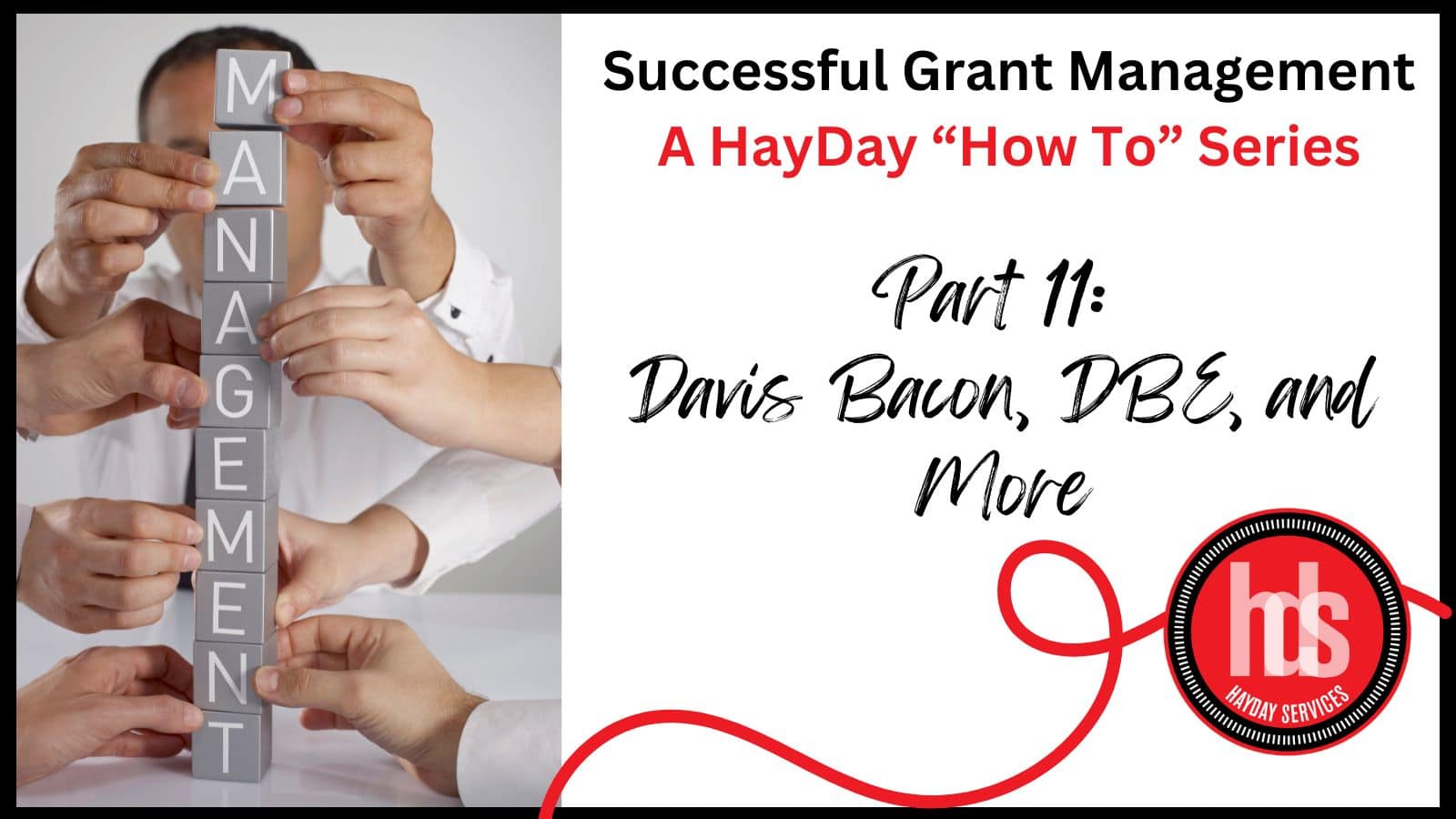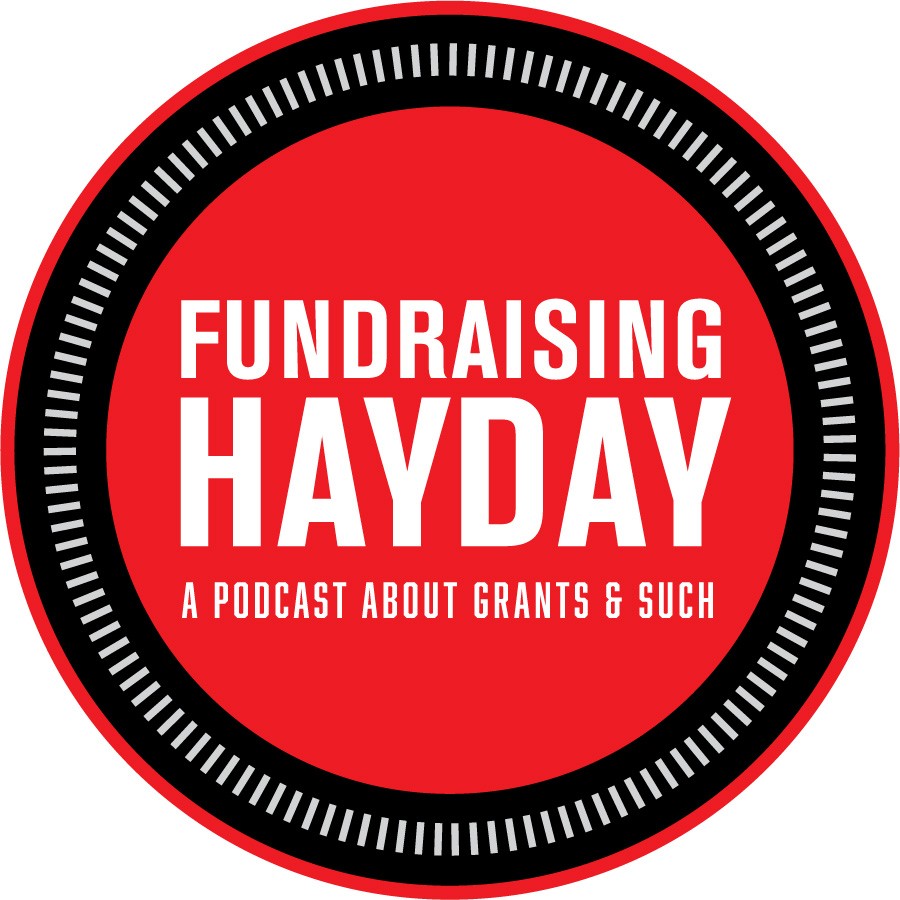HayDay Services is bringing you a series of “how-to” articles related to successful grant management.
Part 11: Davis Bacon, DBE, and More
I’m sure I’ve mentioned this before. The day I was told I was the City of Morrow’s first grants administrator; I had all of one year of adult working experience under my belt as an administrative assistant to the city manager. To say I was tossed into the deep end with no life vest is not an understatement.
I hit the ground running writing and managing federal and state grants for road projects, public safety equipment, and park improvements. While I found some training to hone my skills as a writer, I was totally in the dark when it comes to grant management. I learned to rely on the funder’s project managers and make mistakes (but only once).
Some of the hardest lessons learned centered around all the things that are beyond the OMB’s Uniform Guidance. Sure, that document tells us A LOT about the rules and requirements of grant management, but it isn’t the whole story.
So how do you know about those pesky other requirements? You read your grant award agreement, particularly the terms and conditions section. That’s where you learn if you must meet any Disadvantaged Business Enterprise requirements or follow the Davis Bacon Wage Act. There are many, many requirements that can be listed in the terms and conditions section of a grant award, but these are the two I’m covering today.
DAVIS-BACON ACT
The Davis-Bacon Act (DBA) was created way back in 1931 and named after its sponsors: Senator James J. Davis (Pennsylvania) and Representative Robert L. Bacon (New York). It is part of the United States Code, codified as 40 U.S.C. 3141-3148.
40 U.S.C. 3142 requires the Department of Labor to determine the prevailing wage rates paid to “Corresponding classes of laborers and mechanics employed on projects of a character similar to contract work in the civil subdivision of the State in which the work is to be performed…”
Basically, if your organization received federal funds for a construction project that is $2,000 or more, then DBA applies. Your organization is required to carry out the following:
- Include the predetermined wage rates in bid specifications and contracts. You can look up the appropriate wage rates for a project HERE. This way, any contractor bidding on the job will understand their expenses for labor.
- Once work begins, the contractor and all subcontractors on the job site must turn in weekly certified payroll forms. You can find a copy HERE. These forms list each laborer or mechanic working on the job site, showing their job title, and the hours worked. It also shows their hourly wage and benefits (if provided).
- Your job as grants administrator is to spot check the weekly sheets to make sure workers are being paid the correct wage.
- You will also have to visit the job site, more than once, to conduct wage interviews. You can find a copy in English HERE and in Spanish HERE. I found it helpful to bring both, as I am not bi-lingual. During the site visits, you select a random sampling of employees, conduct the interviews one-on-one, and stay a while to watch work happening. One time, I interviewed someone who stated they were a general laborer who then proceeded to operate a backhoe. That means said individual should be paid the backhoe operator wage, which was significantly higher. There’s a whole process to report what you saw and ensure individuals are paid for the actual labor they are performing.
- All certified payroll forms and wage interviews must be included in your grant management files. And most funders ask for copies to be submitted on a monthly basis as part of the reporting process.
The first time I managed a grant that involved DBA, I was in over my head. The good news is my funder helped walk me through the process. So, if you are a newbie, don’t be afraid to ask questions.
Shortly after that, I attended a 40-hour training, offered for free by the U.S. Housing and Urban Development Department, that provided some helpful instruction on overseeing any project that includes DBA requirements. I highly recommend you find one. If you don’t know where to go for such training, I suggest you reach out to state funders that are pass through agencies for federal construction dollars. A good starting place is your state’s department of transportation.
DISADVANTAGED BUISINESS ENTERPRISE PROGRAM
If you receive funding from the U.S. Department of Transportation, chances are your award agreement will list a Disadvantaged Business Enterprise (DBE) goal. Congress enacted the DBE program in 1983 to help with small business formation and growth. DBE’s are, by definition, a business that is 51% owned by a “socially and economically disadvantaged individual(s).” You can see the full definition and requirements HERE.
If your project has a DBE requirement, you’ll find it in the terms and conditions along with a percentage your organization must meet. For example, if your organization is given a 9% DBE goal, that means that a minimum of your construction funding for the project (aka your grant budget) must be paid towards a DBE firm. Here’s the steps you’ll follow:
- When you advertise the scope of work, you will include the DBE requirement.
- Contractors who bid on the project must include a subcontractor(s) who can do at least 9% of the work, meaning they will receive 9% of the funding.
- The DBE requirement should be included in the contract between your organization and the contractor selected through your bid process. Yes, you’ll follow your organization’s procurement process.
- Then each month, the contractor will complete the DBE monthly report found HERE and provide you with copies of the checks paid to each DBE subcontractor.
- As the grants administrator, you’ll keep copies for your files and share with your funder. They typically like to receive these monthly, usually along with any reimbursement requests.
- You’ll also ensure that the 9% DBE goal is met at the end of the project.
DBE goals can vary from project to project. And it can be easy to overlook this monthly report (ask me how I know). Make sure you keep up with it. That’s so much easier than trying to go back and collect older data.
IN CLOSING
Remember, requirements related to federal funding can be found in the Uniform Guidance, any number of federal regulations, and from policies created by each individual funder. DBA and DBE are just the tip of the iceberg when it comes to regulations you have to follow and report on when in receipt of federal funding. The best way to keep track of the specifics associated with your grant award is to read your grant award agreement AND talk to your funder.
I often reach out to my funder a week or so after I’ve submitted my first round of reporting documents. I want to know if I submitted every requirement document, if information was filled out correctly, and if there was anything else I could change to make the process smoother moving forward.
Grant management involves a lot of paperwork, reporting, and communication. Make sure you fully understand all that is involved, so you aren’t stuck repaying funds, losing a grant, or ruining your organization’s reputation. It can be a lot to keep up with, but it can be done.
Amanda Day, GPC, is a national trainer and speaker. With 20 years of grant prospect research, writing, and management experience, she has the knowledge, know-how, and stories to keep every workshop participant and conference attendee engaged and better prepared to succeed in the grant profession. She is well versed in federal and private grant funding, as well as educating up and using your professional network to best build career path. Her passion lies in preparing grant professionals to successfully fund their organizational and community needs, along with meeting their personal career and leadership goals.
Latest posts by Amanda Day
(see all)




